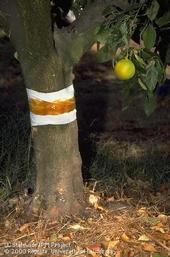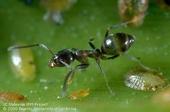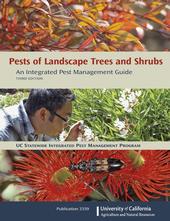
If you have ants climbing up and down trees and shrubs in your landscape, and your trees and shrubs appear to have a sticky substance covering their leaves, you'll want to watch UC IPM's newest YouTube video, “Using a Sticky Barrier to Prevent Ants on Trees and Shrubs”.
The short video explains that the sticky substance on your leaves is honeydew, a sugary substance excreted by aphids, psyllids and a few other plant pests. Ants harvest this...
Using mulch in your garden or landscape helps conserve water and prevent weeds. This new UC IPM video explains how to prepare the site, describes various types of organic mulch available, and demonstrates useful techniques for effective weed control.
For more information on mulch, see the UC IPM website about using mulch in the garden.
See UC IPM's pages on weed identification and control:

Download the free booklet at the bottom of the page!
1. Ants
Most people deal with ants around their home at some point. Because most ants live outdoors, focus efforts on keeping ants from entering buildings by caulking entryways. Follow good sanitation practices to make your home less attractive to ants. Spraying ants inside the home will not prevent more ants from entering. Use baits to control the ant colony. Pesticide baits work by attracting worker ants who then take the poison back to the nest where the entire colony, including queens, can be killed. In the landscape, ants protect...

Completely revised and expanded, Pests of Landscape Trees and Shrubs, 3rd Edition, is a comprehensive, how-to integrated pest management (IPM) resource for landscapers, arborists, home gardeners, retailers, and parks and grounds managers. This easy-to-use guide covers hundreds of insects, mites, nematodes, plant diseases, and weeds that can damage California landscapes.
The book's 435 pages present the practical experience and research-based advice of more than 100 University of California (UC) and industry experts, including:
• Pest-resistant plants and landscape design:
• Planting, irrigating, and other cultural practices that keep plants healthy:
• Conserving natural enemies to...
![Adult (top) and mature nymph of the brown marmorated stink bug. [S. Ausmus]](https://ucanr.edu/blogs/UCIPMurbanpests/blogfiles/34755small.jpg)
The brown marmorated stink bug (Halyomorpha halys) or BMSB is a new invasive pest of urban and suburban homes and landscapes in California.
A native of Asia, the brown marmorated stink bug immigrated into the United States in the 1990s but has only recently been reported in California. The bug prefers to feed on seeds and fruits, so is most damaging to fruit crops; however, it is a polyphagous feeder that may feed on fruit, leaves, or seeds of many ornamental plants as well.
Landscape managers may become most aware of this new pest in the fall when it aggregates in very large numbers on trees or within dwellings, often becoming a nuisance pest.
For more information about the brown marmorated stink bug, read the...


